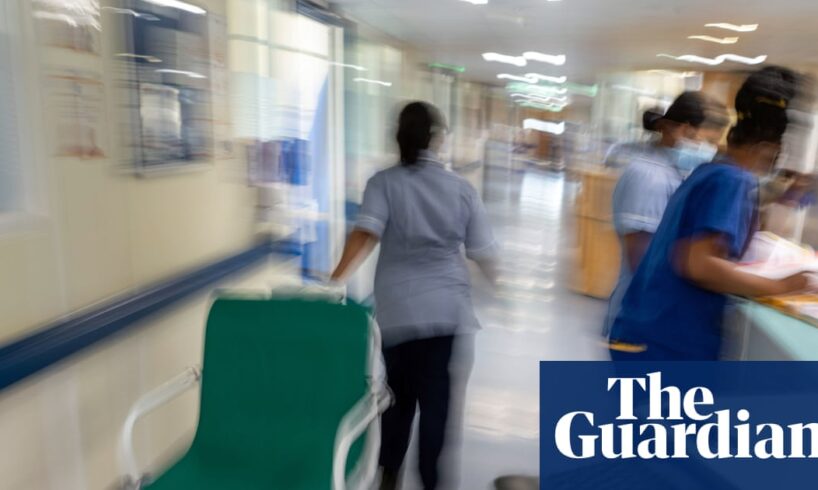
Almost half of the 6 million people needing treatment from the NHS in England have had no further care at all since joining a hospital waiting list, new data reveals.
Previously unseen NHS England figures show that 2.99 million of the 6.23 million patients (48%) awaiting care have not had either their first appointment with a specialist or a diagnostic test since being referred by a GP.
The Patients Association described the situation as “an invisible waiting list crisis” that was “staggering” in scale, with millions living in limbo, anxious as their health deteriorates.
The data raises doubts about Keir Starmer’s repeated pledge that 92% of patients will be treated within 18 weeks of referral by 2029 – his key promise to voters on health. The target has not been hit since 2015, and in May just 61% were treated on time.
In a further sign of how difficult it will be to meet that target, the data shows that a third of the 3 million unseen patients – 1 million people – have already waited more than 18 weeks without receiving any care.
It is the first time the phenomenon of “unseen patients” has emerged as part of the huge challenge facing the government in its drive to “get the NHS back on its feet”. Until now debate around the NHS backlog has focused on the number of treatments patients are due to receive and how many are waiting – currently 7.36m and 6.23m respectively.
“If accurate, 3 million people are trapped in an invisible waiting list crisis, stuck without basic diagnostic tests of first appointments while their conditions worsen,” said Rachel Power, the chief executive of the Patients Association.
“The scale is staggering, as nearly half of all patients on a waiting list haven’t been seen by anyone. That’s not a healthcare service; that’s a breakdown.
“These aren’t just statistics. They’re people checking their phones daily for hospital calls that never come, unable to plan their lives while their symptoms deteriorate.”
The figures have been collated and analysed by the health data specialist MBI Health, which helps dozens of NHS trusts improve their treatment waiting times. It has shared its findings with the Guardian.
Barry Mulholland, the firm’s founder and a former NHS manager, said the health service should see the waiting list as “a frontlog, not a backlog”, because so many people had not had their “first clinical contact” after joining it. In recent years ministers and NHS bosses have made reducing the number of people waiting 12 or 18 months for care their priority.
“There are so many people who have already waited so long without seeing anyone – 3 million unseen patients who haven’t had their first contact.
“Unless that’s dealt with, you will never achieve that target of seeing and treating patients within 18 weeks.
“From the government’s point of view, the pledge to get back to 18 weeks by 2029 will be really hard to accomplish if this huge group of patients isn’t seen more quickly.”
“We’ll never clear the waiting list if we don’t fix the point where patients enter the system, and long delays begin,” he added.
skip past newsletter promotion
Get the day’s headlines and highlights emailed direct to you every morning
Privacy Notice: Newsletters may contain info about charities, online ads, and content funded by outside parties. For more information see our Privacy Policy. We use Google reCaptcha to protect our website and the Google Privacy Policy and Terms of Service apply.
after newsletter promotion
Keir Starmer has pledged that 92% of patients will be treated within 18 weeks of referral by 2029, and in May just 61% were treated on time. Photograph: Toby Melville/PA Media
NHS England acknowledged the vast number of people who had had no NHS care since joining the waiting list. Of the 7.3m treatments patients were waiting for, 4.7m – nearly two-thirds (64%) – were for people who had not had a first consultation with a specialist or a diagnostic test yet.
And 1.6m of this 4.7m had already gone beyond the 18-week supposed maximum waiting time for treatment, it added.
Alison Bennett, a Liberal Democrat health spokesperson, said: “These figures are harrowing. Behind every one of these numbers is a person in pain, anxious about their health, and desperately waiting for their first contact from a clinician.
“This isn’t a problem that appeared overnight; it’s the direct result of the Conservative party mismanaging our NHS for years. It is unacceptable that millions of people are still being left in a state of limbo, while their conditions potentially worsen.”
Ministers would only “fix” the NHS if they overhauled social care to unblock jammed-up hospitals, she added.
MBI’s analysis also found that the medical specialities with the largest number of unseen patients were ear, nose and throat care, orthopaedics, eye care, gastroenterology and gynaecology. Between 67% and 75% of those waiting lists are made up of such patients, Mulholland added.
The Department of Health and Social Care did not comment on the 3 million unseen patients.
A spokesperson said only that: “Thanks to this government’s record investment, reforms and the hard work of NHS staff, we’ve cut the waiting list by over 260,000 since July 2024, which also fell for the first time in 17 years in April and May outside the pandemic. On top of this, we have also delivered 4.6m appointments – more than double the 2m we promised.
“This government is delivering the fundamental reform needed to turn our NHS around, and our 10-year health plan will build on this progress, to ensure we meet our target that 92% of patients wait no longer than 18 weeks for treatment by March 2029.”





